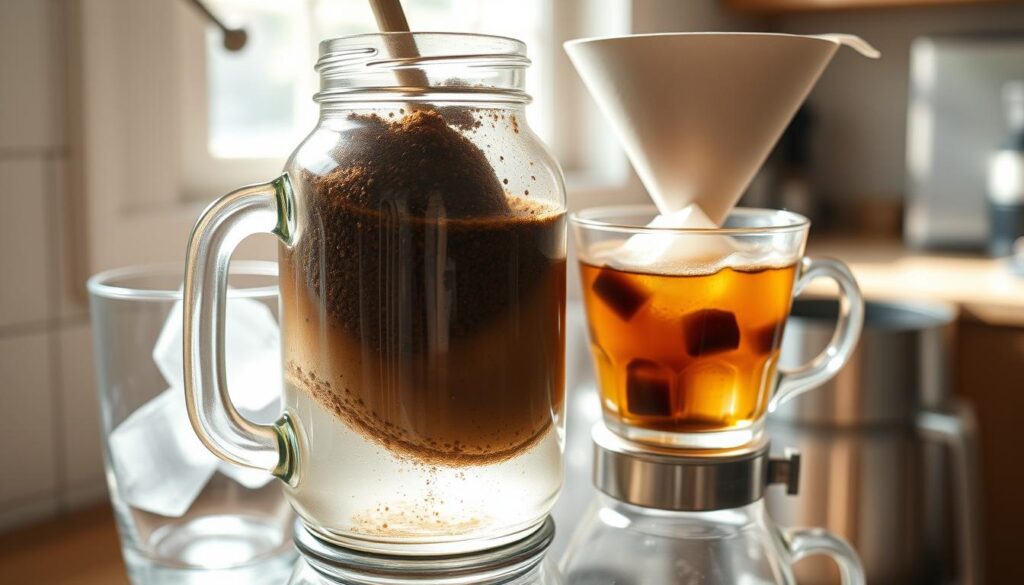Exploring homemade cold brew coffee opens a world of rich flavors. It’s different from traditional brewing methods. Cold brew coffee has changed how people enjoy their coffee, offering a unique taste.
Whether you’re new to coffee or a long-time fan, learning cold brew techniques can change your day. This guide will show you how to make great cold brew coffee at home. You’ll learn about choosing the right beans and brewing with precision.
Cold brew coffee is more than just a drink. It’s a craft that mixes science, technique, and passion. With the right tools and knowledge, you can make coffee that impresses everyone.
Key Takeaways
- Cold brew offers a smoother, less acidic coffee experience
- Specialized equipment isn’t required to make great cold brew
- Choosing the right beans is crucial for exceptional flavor
- Patience is key in the cold brew extraction process
- Experimenting with ratios helps perfect your personal recipe
Understanding Cold Brew Coffee: What Makes It Different
Cold brew coffee has changed how we enjoy coffee. It’s different from traditional brewing methods. This new way of making coffee offers a unique taste experience.
The secret of cold brew is its cold extraction process. It uses cold or room temperature water. This method pulls out coffee’s rich flavors in a way hot brewing can’t.
The Science Behind Cold Extraction
Cold brew’s special preparation is based on science:
- Slower extraction of coffee compounds
- Reduced acid content
- Enhanced smooth flavor profile
Cold Brew vs. Iced Coffee: Key Differences
Many think cold brew and iced coffee are the same. But they’re not. Iced coffee is hot brewed coffee served over ice. Cold brew, on the other hand, steeps coffee grounds in cold water for a long time.
| Cold Brew | Iced Coffee |
|---|---|
| 12-24 hour steep time | Brewed hot and immediately chilled |
| Smoother taste | More traditional coffee flavor |
| Less acidic | Higher acidity |
Benefits of Cold Brew Coffee
Cold brew has many benefits for coffee lovers:
- Lower acidity – easier on the stomach
- Higher caffeine concentration
- Extended shelf life when stored properly
- Versatile for multiple drink preparations
“Cold brew isn’t just a drink, it’s a refined coffee experience that transforms how we appreciate our daily caffeine ritual.”
Whether you love coffee or just enjoy it, knowing about cold brew can make your coffee time better.
Essential Tools and Equipment for Cold Brew Success
Making great cold brew coffee at home needs the right tools. Whether you’re new or a coffee lover, the right equipment makes a big difference.
- Large Glass Container: A wide-mouth mason jar or dedicated cold brew maker works perfectly for brewing
- Filtration System: Quality cold brew filters are crucial for smooth extraction
- Fine Mesh Strainer: Helps separate coffee grounds from liquid
- Storage Pitcher: For keeping your cold brew fresh
Choosing the right cold brew maker makes brewing easier. Here’s a look at some popular ones:
| Type of Maker | Pros | Price Range |
|---|---|---|
| Mason Jar Method | Budget-friendly, easy to use | $5-$15 |
| Specialized Cold Brew Pitcher | Built-in filter, convenient storage | $20-$50 |
| Automatic Cold Brew Machine | Precise brewing, minimal effort | $80-$200 |
“The right equipment transforms good coffee into an exceptional cold brew experience.” – Coffee Brewing Experts
When picking cold brew filters, look for ones that let flavors shine and keep sediment out. Reusable mesh filters are eco-friendly and save money.
Quality cold brew equipment doesn’t have to cost a lot. Start with the basics and add more as you get better at brewing.
Choosing the Right Coffee Beans for Cold Brew
Choosing the right coffee beans for cold brew can make a big difference. It’s not just about picking any beans. You need to think about the roast, the flavor, and how to prepare them.
Cold brew brings out special flavors that hot brewing can’t match. The right beans make a cold brew smooth, rich, and less acidic. It’s a treat for coffee lovers.
Best Roast Profiles for Cold Brew
For cold brew, medium to dark roasts are usually the best. These roasts give:
- Deeper chocolate and nutty flavors
- A robust body and less acidity
- A smooth taste perfect for cold brewing
Single Origin vs. Blends
Deciding between single-origin beans and blends depends on what you like:
| Single Origin | Blends |
|---|---|
| Distinct regional flavors | Balanced and consistent taste |
| Unique, complex flavors | Made for the best cold brew |
| Harder to find | Easier to get |
Grind Size Recommendations
The grind size is key for a great cold brew. A coarse grind is best for:
- Preventing too much extraction
- Smooth filtration
- Keeping the flavor just right
“Coarse ground coffee is the secret to a perfect cold brew experience.” – Coffee Brewing Experts
Pro tip: Aim for a grind size like raw sugar or sea salt for the best cold brew.
Step-by-Step Cold Brew Preparation Method
Making the perfect cold brew at home is simple. The steps are easy, and you need just a few tools. Let’s explore how to make cold brew coffee that will delight your taste buds.
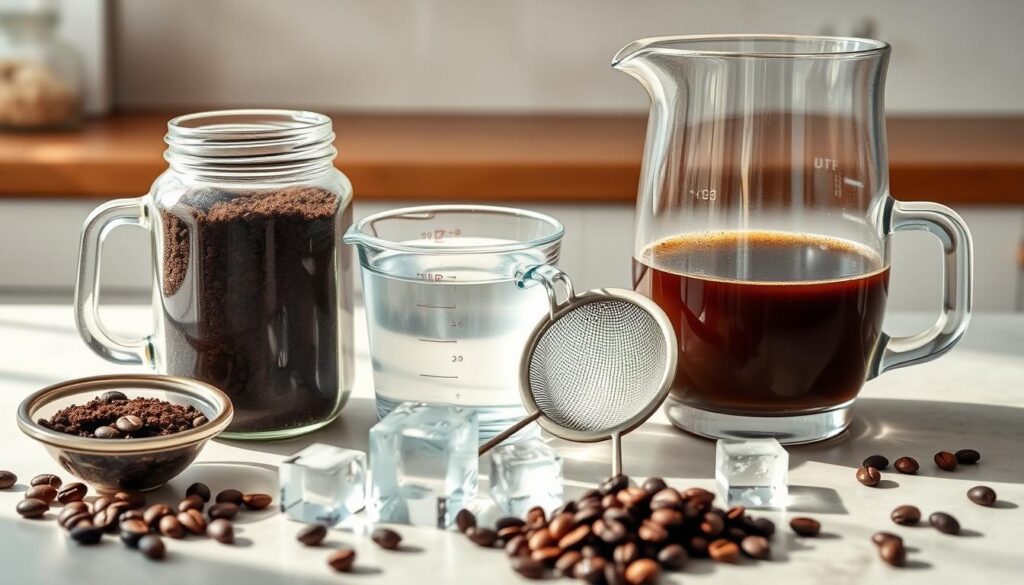
- Coarse ground coffee beans
- Cold or room temperature water
- Large glass jar or pitcher
- Fine mesh strainer or cheesecloth
Here are the steps to make a smooth, tasty cold brew:
- Measure Your Coffee: Use a 1:4 coffee to water ratio. For every cup of water, add 1/4 cup of coarse ground coffee.
- Combine Ingredients: Pour cold water over ground coffee in your container, stirring gently to ensure even saturation.
- Steep Slowly: Cover the container and let it sit at room temperature or in the refrigerator for 12-24 hours.
- Strain Carefully: Use a fine mesh strainer or cheesecloth to filter out coffee grounds completely.
“The secret to great cold brew is patience and quality ingredients.” – Coffee Enthusiast
Pro tip for your cold brew recipe: Try different steeping times to find your favorite flavor. Shorter steeps make the coffee lighter, while longer steeps make it stronger and more intense.
Perfect Coffee-to-Water Ratios for Cold Brew
Making the perfect cold brew needs careful coffee-to-water ratio. Knowing these ratios can make your brewing at home amazing.
Cold brew concentrate is a strong base for many coffee drinks. The goal is to find the right mix of coffee and water for the best flavor.
Concentrate vs. Ready-to-Drink Ratios
Cold brew ratios change a lot between concentrate and ready-to-drink:
- Concentrate Ratio: 1:4 or 1:5 (coffee to water)
- Ready-to-Drink Ratio: 1:8 or 1:10 (coffee to water)
Precise Cold Brew Measurements
| Coffee Type | Water Amount | Resulting Volume |
|---|---|---|
| Concentrate | 1 cup grounds | 5 cups liquid |
| Ready-to-Drink | 1 cup grounds | 8-10 cups liquid |
“Precision is the soul of cold brew magic” – Coffee Enthusiasts
Scaling your cold brew? Keep these tips in mind:
- Use a kitchen scale for accurate measurements
- Experiment with ratios to find your perfect strength
- Adjust water temperature for optimal extraction
Pro tip: Start with a standard cold brew ratio and adjust to suit your taste preferences.
Cold Brew Steeping Time and Temperature Guidelines
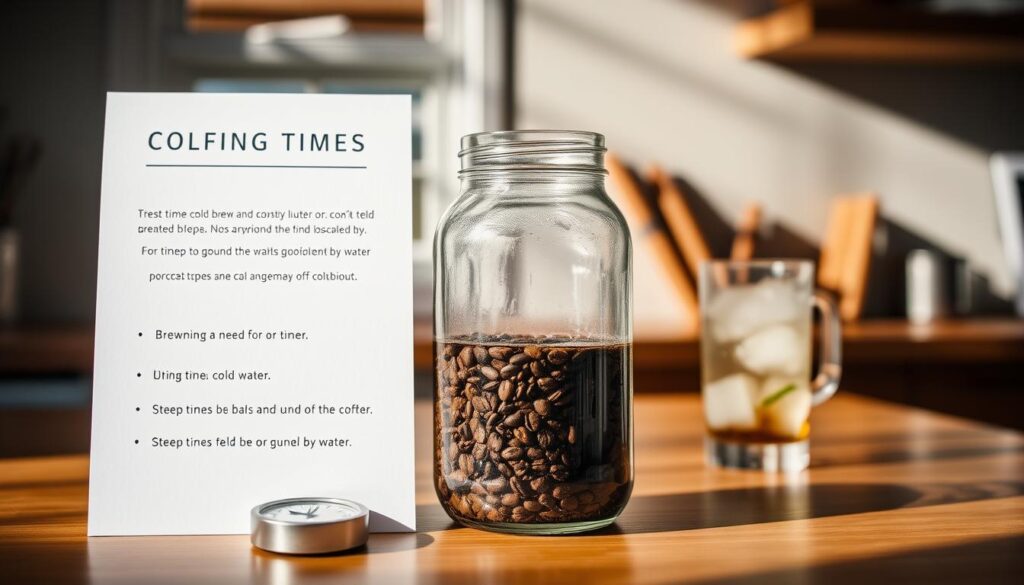
Getting the cold brew steeping time and temperature right is key to making great cold brew coffee. The way it extracts flavors is different from hot brewing. It needs patience and careful attention.
The temperature of the water is very important for flavor. Most people say to use water between 35-70°F for the best taste. The brewing time can be anywhere from 12 to 24 hours, depending on how strong you like it.
“The magic of cold brew lies in its slow, gentle extraction process that brings out smooth, rich flavors without bitterness.”
- Optimal cold brew steeping time: 12-24 hours
- Recommended water temperature: 35-70°F
- Factors affecting extraction: Water temperature, grind size, coffee-to-water ratio
How long you steep your cold brew can change its taste a lot. A shorter steeping time around 12 hours gives a lighter, more delicate flavor. Steeping for 24 hours makes it stronger and more intense.
Pro tip: Experiment with various cold brew steeping times to find your perfect balance of flavor and strength.
Keeping the temperature right is also crucial. Cooler water extracts flavors slower, making the coffee smoother and less acidic. Don’t use hot water, as it can make the coffee bitter and ruin its smooth taste.
Filtering and Storage Best Practices
Making the perfect cold brew coffee is more than just brewing. Filtering and storing it right are key to keeping its quality and taste.
Getting a smooth, clear cold brew depends on the right filters. The filtering method affects its clarity and taste.
Filtering Methods and Materials
There are several ways to filter cold brew effectively:
- Cheesecloth: An affordable, traditional filtering method
- Paper filters: Provide excellent sediment removal
- Fine mesh strainers: Ideal for initial large particle separation
- Reusable cloth filters: Environmentally friendly option
Cold Brew Storage Solutions
Storing cold brew properly is crucial for keeping it fresh. Glass containers with tight lids are best for flavor and to prevent contamination.
Cold brew can last 7-10 days in the fridge if stored right. To keep it longer, use an airtight container and avoid strong smells.
“The key to great cold brew is not just in the brewing, but in how you filter and store it.” – Coffee Enthusiast Magazine
Pro tip: Refrigerate your cold brew right after filtering. This keeps its flavor and prevents bacteria.
Common Cold Brew Mistakes and How to Avoid Them
Cold brew coffee can be tricky for beginners. But knowing common mistakes helps you make the perfect drink. Cold brew troubleshooting needs attention to detail and a willingness to learn.
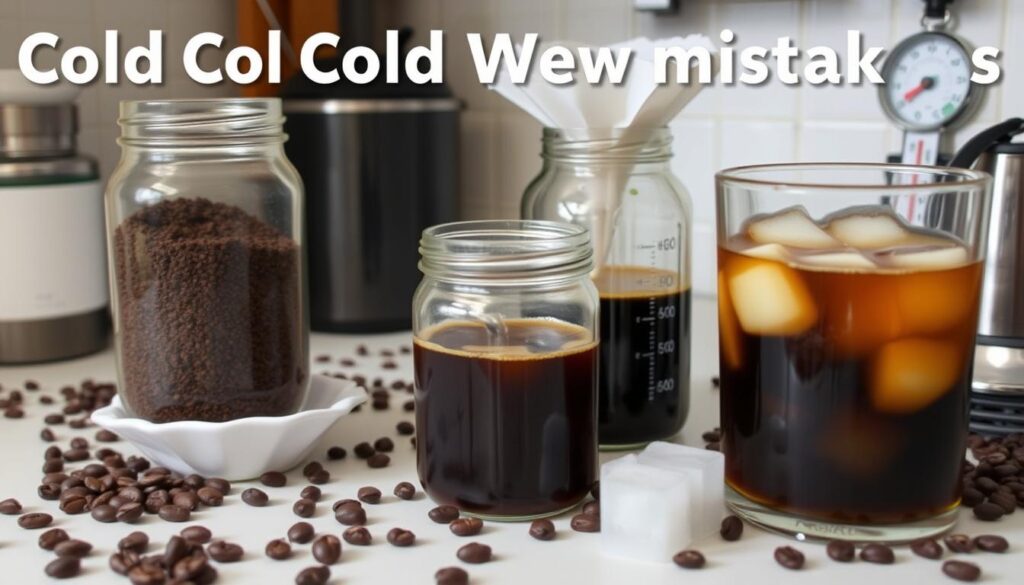
Mastering cold brew means avoiding several key pitfalls. These can ruin your coffee’s flavor and quality. Let’s look at the most common mistakes and how to fix them:
- Incorrect Coffee Grind: Fine grounds make coffee bitter. Use a coarse, consistent grind for cold brew.
- Wrong Water-to-Coffee Ratio: Getting the ratio right is key. Start with 1:4 or 1:5 and adjust to taste.
- Inconsistent Steeping Time: Steeping time should be between 12-24 hours. Short times make coffee weak, long times bitter.
*Pro Tip*: Cold brew is forgiving, but precision makes great coffee.
Knowing these tips can improve your brewing. Experiment and track your results to find your perfect technique.
| Mistake | Consequence | Solution |
|---|---|---|
| Fine Grind | Bitter, Over-Extracted | Use Coarse Grind |
| Wrong Ratio | Weak or Strong Brew | Measure Precisely |
| Poor Filtration | Sediment in Coffee | Use Fine Mesh Strainer |
Cold brew troubleshooting is about patience and practice. Avoiding these mistakes will make your cold brew smooth and delicious every time.
Creative Cold Brew Recipes and Variations
Cold brew coffee opens up a world of delicious possibilities. From classic to innovative, these recipes will change your coffee experience. They will also excite your taste buds.
Classic Cold Brew Recipes
Begin your cold brew journey with these foundational recipes. They highlight the smooth, rich flavor of cold brew coffee:
- Traditional Cold Brew Concentrate
- Smooth Vanilla Cold Brew
- Cinnamon Swirl Cold Brew
Flavored Cold Brew Innovations
Elevate your cold brew with unique flavor combinations. These creative options will add excitement to your daily coffee routine:
- Lavender Honey Cold Brew
- Coconut Caramel Cold Brew
- Maple Pecan Cold Brew
Cold Brew Cocktails
For a more adventurous coffee experience, try cold brew cocktails. These drinks mix the rich depth of cold brew with spirited ingredients:
| Cocktail Name | Key Ingredients | Flavor Profile |
|---|---|---|
| Espresso Martini | Cold brew, vodka, coffee liqueur | Rich and bold |
| Irish Cold Brew | Cold brew, Irish whiskey, cream | Smooth and creamy |
| Cold Brew Negroni | Cold brew, gin, Campari, vermouth | Complex and robust |
“Cold brew is not just a drink, it’s a canvas for culinary creativity.” – Coffee Enthusiast
Each of these cold brew recipes offers a unique way to enjoy your favorite caffeinated beverage. Whether you like classic, innovative flavors, or spirited cocktails, there’s a recipe for you.
Seasonal Cold Brew Adaptations
Crafting seasonal cold brew variations changes your coffee experience all year. Each season offers a chance to try new cold brew flavors. These flavors capture the essence of the moment.
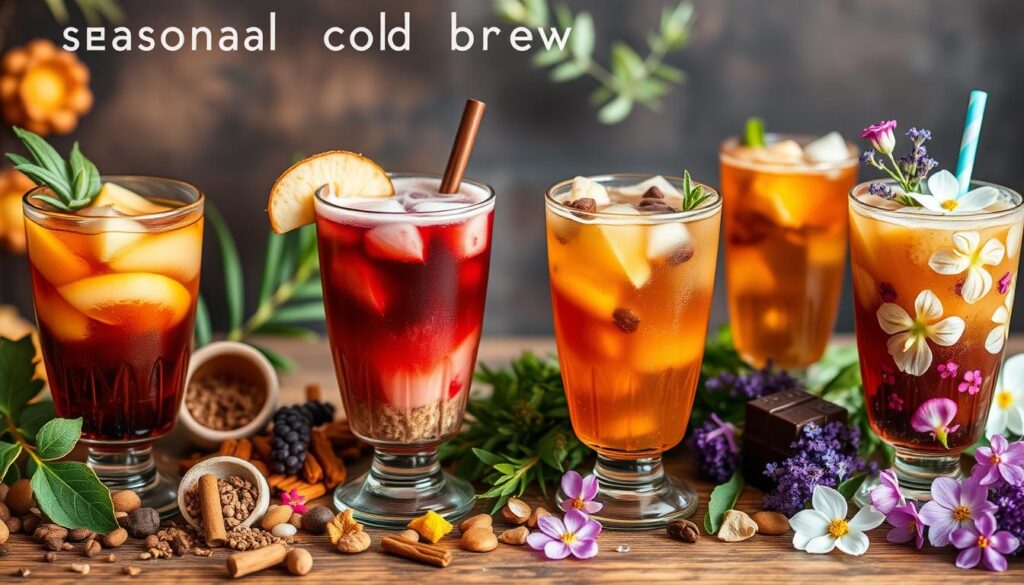
Summer is the time for refreshing cold brews that cool and invigorate. Light, fruity flavors are perfect for the warm months. Here are some seasonal cold brew ideas:
- Citrus-infused summer cold brew with orange and lemon zest
- Tropical cold brew featuring pineapple and coconut notes
- Watermelon mint cold brew concentrate
Autumn is the season for warm spices in cold brew flavors. Pumpkin spice, cinnamon, and caramel make rich, comforting drinks. These drinks blend iced and hot coffee experiences.
| Season | Cold Brew Flavor Profile | Key Ingredients |
|---|---|---|
| Summer | Light, Fruity | Citrus, Tropical Fruits |
| Autumn | Warm, Spicy | Pumpkin, Cinnamon, Caramel |
| Winter | Rich, Decadent | Chocolate, Nutmeg, Vanilla |
| Spring | Light, Floral | Lavender, Honey, Berry |
Winter calls for rich, decadent cold brews. Chocolate, nutmeg, and vanilla make indulgent drinks. Spring brings light, floral flavors like lavender and honey.
Seasonal cold brew is an art form that celebrates coffee’s versatility and the changing landscape of taste.
Trying seasonal ingredients makes your cold brew a culinary adventure. Each variation tells a story of time, place, and personal creativity.
Scaling Up: Making Large Batches of Cold Brew
Making large batches of cold brew for parties needs careful planning. You must know how to keep the quality high while making more. It’s all about the right techniques.
“Scaling up cold brew isn’t just about multiplying ingredients – it’s about preserving the smooth, rich flavor that makes cold brew special.” – Coffee Brewing Expert
Here are key tips for large batch cold brew:
- Invest in large-capacity brewing containers
- Use commercial-grade filtration systems
- Maintain consistent coffee-to-water ratios
- Choose robust coffee beans that scale well
For large batch cold brew, choose a container that’s food-grade and non-reactive. It should also be easy to stir. Stainless steel or high-quality glass containers are best for keeping flavors intact.
Here’s what you’ll need for large batch cold brew:
- Large brewing buckets with tight-fitting lids
- Commercial-grade mesh filters
- Digital scale for precise measurements
- Refrigeration space for consistent temperature
Pro tip: When scaling up cold brew for parties, prepare concentrate and dilute just before serving to ensure maximum freshness and flavor.
Conclusion
Cold brew coffee is more than just a drink—it’s an art form waiting for you to explore. This guide has given you the essential tips and techniques to make smooth, rich cold brew at home. Whether you love coffee or are just starting, you can master cold brew.
The beauty of cold brew is its simplicity and flexibility. You’ve learned how to pick the right beans and experiment with steeping times and flavors. Each batch is a chance to improve your technique and find your perfect brewing style.
Remember the cold brew summary we started with? It’s not just a method—it’s a doorway to a world of delicious, low-acid coffee. By using the strategies we discussed, you can change your home brewing routine. You’ll impress friends and family with cold brew that’s just right for you.
Your cold brew journey is just starting. Keep exploring, stay curious, and don’t be afraid to try new things. With practice and passion, you’ll become a cold brew expert who can make amazing coffee with ease.
FAQ
What is cold brew coffee?
Cold brew coffee is made by steeping coarse coffee grounds in cold water for 12-24 hours. This method creates a smooth, less acidic coffee concentrate. It’s perfect for serving chilled or over ice.
How is cold brew different from regular iced coffee?
Cold brew is not brewed hot like iced coffee. Instead, it’s made by steeping coffee in cold water for a long time. This makes it smoother and less bitter than hot brewed coffee.
What type of coffee beans work best for cold brew?
Medium to dark roast coffee beans are best for cold brew. Use coarse grounds to avoid bitterness and ensure a clean taste.
How long can I store homemade cold brew?
Homemade cold brew can last 7-10 days in the fridge if stored in an airtight container. For the best taste, drink it within 5 days.
Can I make cold brew without special equipment?
Yes, you can make cold brew with simple tools like a mason jar and cheesecloth. While specialized makers are convenient, they’re not required.
Is cold brew stronger than regular coffee?
Cold brew is more concentrated than drip coffee. People usually dilute it with water or milk to get the right strength.
What is the ideal coffee-to-water ratio for cold brew?
Use a 1:4 or 1:5 coffee-to-water ratio for concentrate. This means 1 cup of coffee to 4-5 cups of water. Dilute it with water or milk when serving.
Can I heat up cold brew coffee?
Yes, you can heat cold brew. It’s traditionally served cold but can be warmed up without losing its smooth flavor. Just dilute it with hot water or warm it gently in the microwave.
Are there health benefits to drinking cold brew?
Cold brew has lower acidity than hot coffee, which is easier on the stomach. It also has the same antioxidants and health benefits as regular coffee, like improved alertness and metabolism.
How can I customize my cold brew?
Cold brew is very versatile! You can add flavors like vanilla or cinnamon, make coffee cocktails, mix with different milks, or use it in iced coffee drinks and desserts.
Share this post: on Twitter on Facebook

